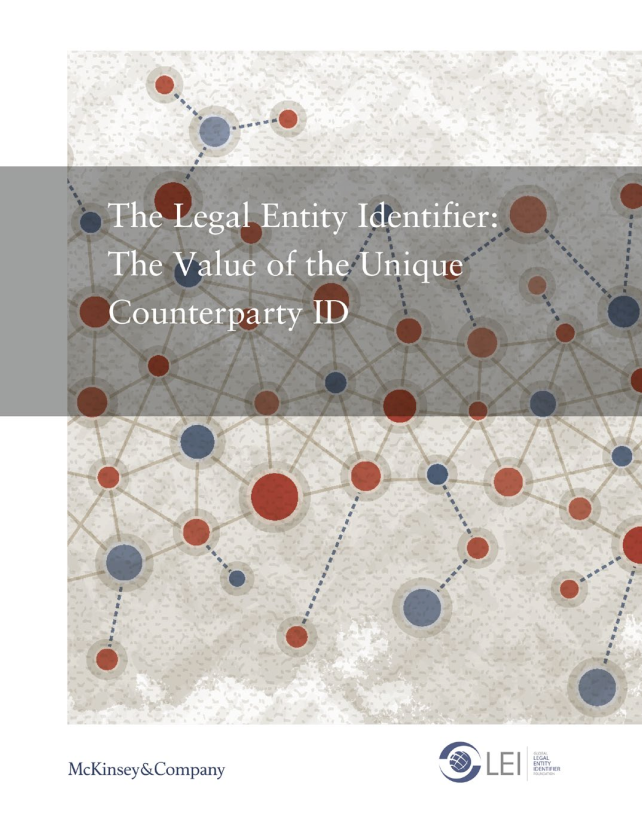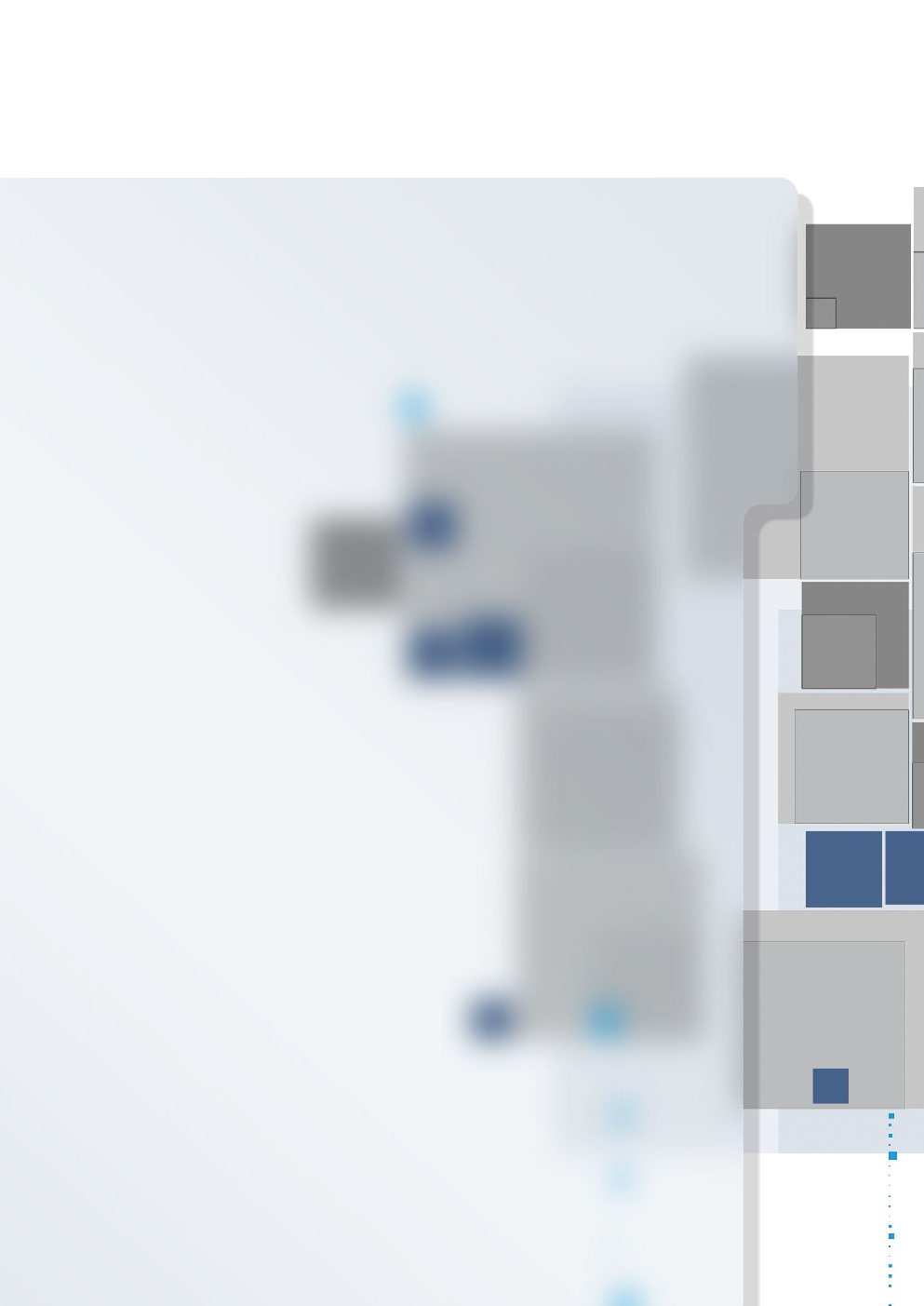





| 4 | LEIs Worldwide |
| 6 | GLEIF and Global LEI System |
| 8 | 2017 Highlights |
| 12 | Chairman's Report |
| 14 | CEO's Report |
| 18 | Performance |
| 27 | Directors' Report |
| 30 | Governance Statement |
| 34 | LEI for Business Value |
| 40 | Partnerships |
| 43 | Financial Statements 2017 |
| 51 | Notes to the Financial Statements 2017 |
| 78 | Independent Auditor's Report |
| 81 | Board of Directors, CEO, LEI ROC Chairs and Executive Team |
| 88 | Overview of Professional Advisors |
| 89 | General Information |
We do this by facilitating the implementation of the Legal Entity Identifier (LEI) and by making available the Global LEI Index. The Global LEI Index is a central portal that captures entity data and ownership data. It is the only global online source that provides open, standardized and high-quality legal entity reference data which can be accessed free of charge by any user.
We deliver trusted services and reliable data for unique entity identification management in partnership with the LEI issuing organizations. Our joint efforts have generated great results. Our data pool nearly doubled in size reaching almost one million LEIs assigned to entities of global transactions.
Our services ensure the operational integrity of the Global LEI System. We promote the adoption of shared open data principles, standards and best practice across sectors around the world. By doing so, the LEI remains the industry standard best suited to providing quality-assured data for entity identification management.
Established by the Financial Stability Board, GLEIF is a not-for-profit organization with a global mandate to deliver the LEI as a broad public good for any user in the public and private sector. GLEIF’s international governance framework reinforces the global nature of its mission.





How the LEI can reduce costs and increase
operational efficiency
“The Legal Entity Identifier:
The Value of the Unique Counterparty ID,”
October 2017
New research undertaken by McKinsey & Company and GLEIF estimate that broader, global adoption of LEIs could yield annual savings of over US$ 150 million within the investment banking industry and up to US$ 500 million for banks in the issuance of letters of credit. Annual savings in investment banking would include at least 10% of total operational costs for onboarding clients and trading processing through the use of the LEI.
McKinsey & Company has been working with GLEIF to examine the potential use cases of the LEI in streamlining entity verification processes.
Collectively, these benefits reduce the time spent on identifying counterparties and improve the reliability of information.
The white paper identifies three new use cases for LEIs: capital markets, commercial transactions and the exten- sion of commercial credit. These are especially relevant to large corporations, small businesses and their bank- ing institutions, and investment banks.
Analysis taken as part of this project also indicates that there are multiple additional use cases beyond the three identified. Operational efficiencies, cost savings, reduction of time
to transact with clients and more reliable information can be gained by introducing the LEI into almost any process that requires identification and verifi- cation of a counterparty and that has a manual compo- nent. This resulting easier counterparty identification will open the door to further automation and digitalization of financial and commercial transactions across the globe.
To learn more about how the LEI brings efficiency, trans- parency and trust to legal entity identification, visit the GLEIF website: www.gleif.org
The LEI’s primary value is derived from reducing the cost of onboarding clients and of middle- and back-office activities related to the processing of stocks, bonds and other securities trades. All such activities could be simplified and streamlined if LEI use were more broadly adopted throughout the lifecycle of the client relationship. The use of the LEI would also reduce the time spent on data correction and reconciliation.
LEIs would enable faster processing of letters of credit and better identification of sellers on e-invoicing networks.
LEIs would allow for more robust and efficient know-your-customer (KYC) diligence on borrowers, as well as better traceability of information on borrowers from multiple sources.


Basel
Board of Directors Meeting 2017-01-18
GLEIF participated in almost 50 conferences, round tables, or promotional meetings with stakeholders, and deepened engagement with communities such as the business registers.
GLEIF hosted the annual GLEIF-LOU meeting with the LEI issuing organizations in Frankfurt to exchange ideas on core projects such as the Level 2 ownership data collection with a view to jointly improve services for the users of the LEI data.


Frankfurt
Board of Directors Meeting 2017-06-28
The Board of Directors met four times in-person during the year including twice with the LEI ROC Executive Committee to hold dialogue on the Global LEI System.


Moscow
Board of Directors Meeting 2017-04-05
Meet the Market event 2017-04-04
GLEIF continued cooperation with its stakeholder groups including data and technology vendors and large statistical users.


Toronto
Board of Directors Meeting 2017-10-25
In 2018, GLEIF will widen its dialogue with data users of regulatory organizations and of the Global Systemically Important Financial Institutions (G-SIFIs). GLEIF will further pursue strategic partnerships with companies interested in identification management.
| Notes | Jan. to Dec. 2017 | Jan. to Dec. 2016 | ||||
|---|---|---|---|---|---|---|
| US$ | US$ | |||||
| Fee revenue | 3.1 | |||||
| Wages and salaries | - | - | ||||
| Social contributions and expenses for pensions and care | - | - | ||||
| Personnel expenses | 3.2 | - | - | |||
| Other operating expenses | 3.3 | - | - | |||
| Other operating income | 3.4 | |||||
| Amortization and depreciation expense | 4.5/4.6 | - | - | |||
| Operating surplus | - | |||||
| Subsidies and donations | 3.5 | |||||
| Financial income/expense | 3.6 | - | ||||
| Net surplus | ||||||
| Changes of components of net equity from actuarial gains and losses in pension and similar obligations | 3.2 | - | ||||
| Items that will not be reclassified to net surplus | - | |||||
| Other comprehensive income | - | |||||
| Total comprehensive income |
| Assets | Notes | Dec. 31, 2017 | Dec. 31, 2016 | |||
|---|---|---|---|---|---|---|
| US$ | US$ | |||||
| Receivables from LEI issuer feeds | 4.1 | |||||
| Current financial assets | 4.2 | |||||
| Other assets | 4.3 | |||||
| Cash and cash equivalents | 4.4 | |||||
| Current assets | 4.4 | |||||
| Intangible fixed assets | 4.5 | |||||
| Tangible fixed assets | 4.6 | |||||
| Financial assets | 4.2 | |||||
| Non-current assets | ||||||
| Liabilities and equity | ||||||
| Payables due to vendors | 4.7 | |||||
| Liabilities due to Board Directors | 6.1 | |||||
| Deferred revenue | 4.8 | |||||
| Other financial liabilities | 4.9 | |||||
| Other payables | 4.10 | |||||
| Current liabilities | ||||||
| Provision for pension costs | 3.2 | |||||
| Payables due to vendors | 4.7 | |||||
| Financial liabilities | 4.9 | |||||
| Deferred subsidies | 3.5 | |||||
| Non-current liabilities | ||||||
| Paid-in Foundation capital | ||||||
| Other reserves | - | |||||
| Retained surplus | ||||||
| Organizational capital | 4.11 | |||||
| Notes | Dec. 31, 2017 | Dec. 31, 2016 | ||||
|---|---|---|---|---|---|---|
| US$ | US$ | |||||
| Surplus | ||||||
| Amortization and depreciation expense | ||||||
| Increase (decrease) of provisions | ||||||
| Financial income/expense | - | |||||
| Other non-cash expenses and income | - | |||||
| Decrease/increase of receivables and other current assets | - | |||||
| Increase/decrease of liabilities to vendors and other operating liabilities | ||||||
| Interest received | ||||||
| Cash flow from operating activities | - | |||||
| Acquisition of intangible and tangible fixed assets | 4.5/4.6 | - | - | |||
| Acquisition/settlement of financial assets | 4.2 | |||||
| Cash flow from investing activities | - | - | ||||
| Repayment of finance lease liabilities | - | - | ||||
| Proceeds from other financing liabilities | - | |||||
| Interest paid | - | - | ||||
| Cash flow from financing activities | - | |||||
| Total cash flow effects on cash and cash equivalents | - | |||||
| Effect of changes in exchange rates on cash and cash equivalents | - | |||||
| Cash and cash equivalents at beginning of period | ||||||
| Cash and cash equivalents at end of period | 4.4 |
| Notes | Paid-in Foundation capital | Other reserves, actuarial gains and losses from pension obligations | Retained surplus | Organizational capital | ||||||
|---|---|---|---|---|---|---|---|---|---|---|
| US$ | US$ | US$ | US$ | |||||||
| Balance as of December 31, 2015 | 4.11 | - | ||||||||
| Net surplus | ||||||||||
| Other comprehensive income | - | - | ||||||||
| Total comprehensive income | - | |||||||||
| Balance as of December 31, 2016 | 4.11 | - | ||||||||
| Net surplus | ||||||||||
| Other comprehensive income | ||||||||||
| Total comprehensive income | ||||||||||
| Balance as of December 31, 2017 | 4.11 |
The accompanying financial statements present the operations of Global Legal Entity Identifier Foundation with its registered office in Basel, Switzerland (hereinafter: “GLEIF” or “the Foundation”).
GLEIF is a foundation according to Swiss civil law, and registered under no. CHE-200.595.965 in the commercial register of Basel-Stadt, Switzerland. The address of the Foundation is St. Alban-Vorstadt 5, 4002 Basel, Switzerland. In February 2015, GLEIF began operating a permanent establishment in Frankfurt am Main, Germany, where the main operating activities of the Foundation are located.
GLEIF was founded on June 26, 2014 by the Financial Stability Board, an association under Swiss law. The purpose of GLEIF is to establish, maintain and monitor the Global Legal Entity Identifier System (“Global LEI System”) which provides a worldwide unique identification number (the “LEI”) for all parties of financial transactions.
The establishment of this system has been required by the Heads of State and Government of the Group of Twenty, calling the Financial Stability Board to coordinate the work among the regulatory bodies. Prior to the foundation of GLEIF, the Financial Stability Board established the Regulatory Oversight Committee (“LEI ROC”) which had set forth requirements for the structure of the Global LEI System and for the managing, monitoring and standard setting functions, as well as the internal structure and the funding of the GLEIF. The LEI ROC has, as stipulated in Article 4 of the Statutes, the regulatory oversight of the Global LEI System, including the activities of GLEIF, in the broad public interest.
GLEIF is under supervision of the Swiss Supervisory Board of Foundations since the establishment of the GLEIF in June 2014.
The financial statements have been authorized for publication by the Board of Directors on March 14, 2018.
These financial statements have been prepared in accordance with International Financial Reporting Standards (IFRS) as issued by the International Accounting Standards Board (IASB). GLEIF also prepares a set of statutory financial statements in accordance with the Swiss Code of Obligations
These financial statements are presented in US dollars (US$), with rounding to the nearest dollar, unless otherwise stated.
The financial statements are prepared on the historical cost basis, unless otherwise stated in the accounting policies.
The accounting policies set out below are unchanged from the prior period and have been applied consistently throughout both periods.
The functional currency of GLEIF is the US dollar, as the Foundation generates its revenues and receives almost all cash flows from the LEI issuers (also referred to as Local Operating Units (”LOU”)) in this currency.
Transactions that are denominated in a currency other than the US dollar are recorded at the spot exchange rate at the date when the underlying transactions are initially recognized. At the end of the reporting period, foreign currency-denominated monetary assets and liabilities are retranslated into US dollars applying the spot exchange rate prevailing at that date. Gains and losses arising from these foreign currency revaluations are recognized in income.
The exchange rates of the most significant foreign currencies are:
| Dec. 31, 2017 | Dec. 31, 2016 | |||
|---|---|---|---|---|
| US$ | US$ | |||
| Swiss franc to US dollar | 1.0249 | 0.9816 | ||
| Euro to US dollar | 1.1993 | 1.0541 |
Revenue is measured at the fair value of the consideration received or receivable net of discounts and rebates and excluding taxes or duty. Revenue is recognized over the term of the license period on an accrual basis.
The revenue of GLEIF is based on arrangements with the LEI issuers to pay to GLEIF a fixed service fee for each LEI issued and served by the respective issuer.
The license period of a LEI is one year from the date of issuance or renewal. During this period, the LEI issuers are responsible to manage and maintain the integrity and accuracy of the LEI entry data and of the related changes. The services provided by GLEIF to the LEI issuers relate to quality assurance, standardization, and certain other work with regard to the LEI issuers’ management of LEIs. Accordingly, the revenue of GLEIF is related to the service periods of the LEIs. On a straight-line basis, GLEIF recognizes the revenue over the terms of the contracts between the LEI issuers and the LEI users, and defers the revenue which is allocated to the portion of the LEI service periods remaining after the balance sheet date. The outstanding portion of the LEI service periods is estimated based on quarterly performance reports of each LEI issuer.
The service contracts agreed with the LEI issuers in the past years (“commitment letter”) set forth a fixed annual service fee for each LEI issued or renewed in the respective calendar year. Quarterly or annual advances are paid by the LEI issuer during the year, and only the final invoice or credit note is accounted for as a receivable or payable in the balance sheet. The revenue portion deferred to the next fiscal year from these kind of arrangements is shown as a separate deferral liability.
During 2017, the new “master agreement” arrangement has been set forth for the majority of LEI issuers. Under this contract, the LEI issuer pays a quarterly service fee based on all active LEIs under its management at the end of the quarter. According to the revenue recognition assumptions described above, 50% of the service fee charged at the end of each quarter is not recognized until the subsequent quarter. For service fees under this new agreement, GLEIF only reflects in the balance sheet the 50% portion of the quarterly service fee relating to the services recognized for the ending quarter as revenue during the period, the remaining 50% that has neither been earned nor billed at quarter end is not shown in the balance sheet and only recognized in the subsequent quarter.
A government grant or assistance is recognized only when there is reasonable assurance that GLEIF will comply with any conditions attached to the grant and the grant will be received. The grant is recognized as income over the period necessary to match with the related costs, for which they are intended to compensate, on a systematic basis. A grant receivable as compensation for costs already incurred or for immediate financial support, with no future related costs, is recognized as income in the period in which it is receivable. A grant relating to assets (capitalized expenditure) is recognized as deferred income (liability), and released in accordance with the amortization of the related assets.
Interest income and expense are recognized using the effective interest method. The effective interest rate is established on initial recognition of the financial asset or liability and is not revised subsequently.
Since 2015, the Foundation’s activities are located in Basel, Switzerland, and in Frankfurt am Main, Germany. GLEIF is free from Swiss income taxes based on an assessment of the tax authority Basel-Stadt, Switzerland. In Germany, the activities of GLEIF to manage and monitor the Global LEI System are free from corporate and trade tax on income by law.
A provision is recognized in the balance sheet when the Foundation has a present legal or constructive obligation as a result of a past event, it is probable that an outflow of economic benefits will be required to settle the obligation and a reliable estimate can be made of the amount of the obligation. If the effect is material, provisions are recognized at present value by discounting the expected future cash flows at a rate that reflects current market assessments of the time value of money. When a contract becomes onerous, the present obligation under the contract is recognized as a provision and measured at the lower of the expected cost of fulfilling the contract and the expected cost of terminating the contract as far as they exceed the expected economic benefits of the contract. Additions to provisions and reversals are generally recognized in the income statements.
Provisions for pension obligations are recognized by using the projected unit credit method, based on reasonable assumptions for the long-term expected rate of salary increases and benefit increases, demographic assumptions and long-term interest rates as of the balance sheet date. The related plan assets are recognized at their fair value, in accordance with IAS 19.
A lease is classified as a finance lease if it transfers substantially all the risks and rewards incidental to ownership. All other leases are classified as operating leases.
GLEIF recognizes assets held under finance leases at the fair value at the inception of the lease or if lower, at the present value of the minimum lease payments. The related liability to the lessor is included in the balance sheet as a finance lease obligation. Lease payments are apportioned between interest expenses and capital redemption of the liability.
Contingent rentals are recognized as expenses in the periods in which they are incurred.
GLEIF recognizes operating lease payments as an expense on a straight-line basis over the lease term. Contingent rentals arising under operating leases are recognized in the period in which they are incurred. Lease incentives and similar arrangements of incentives are taken into account when calculating the straightlined expense.
GLEIF items of tangible fixed assets are initially measured at cost. Cost includes expenditures that are directly attributable to the acquisition of each item. Tangible fixed assets are subsequently measured at cost less accumulated depreciation and any accumulated impairment losses. Depreciation is charged to allocate the cost of assets less their residual values over their estimated useful lives, using the straight-line method.
The estimated useful lives of all items of tangible fixed assets are as follows:
| Technical and computer equipment | 3 to 5 years | |
| Motor vehicles | 6 years | |
| Office equipment | 6 to 10 years | |
| Apartment equipment | 3 to 5 years |
Separately acquired items of intangible fixed assets are initially measured at cost. Cost includes expenditures that are directly attributable to the acquisition of each item. After initial measurement, intangible fixed assets are measured at cost less accumulated amortization and any accumulated impairment losses. Amortization is charged on a straight-line basis over the estimated useful lives of the intangible fixed assets.
The estimated useful lives of intangible assets are as follows:
| Software | 3 to 5 years |
As at the end of the current fiscal year, GLEIF did not have intangible assets with an indefinite useful life.
A financial instrument is any contract that gives rise to a financial asset of one entity and a financial liability or equity instrument of another entity. Financial assets of the Foundation mainly include cash and cash equivalents, long- and short-term security deposits and receivables from LEI issuers’ fees. Financial liabilities of the Foundation mainly comprise payables to vendors, and to employees and Board Directors. GLEIF does not make use of the option to designate financial assets or financial liabilities at fair value through profit or loss at inception (Fair Value Option). Based on their nature, financial instruments are classified as financial assets and financial liabilities measured at cost or amortized cost and financial assets and financial liabilities measured at fair value.
Financial instruments are recognized on the balance sheet when GLEIF becomes a party to the contractual obligations of the instrument. Regular way purchases or sales of financial assets, i.e. purchases or sales under a contract whose terms require delivery of the asset within the time frame established generally by regulation or convention in the marketplace concerned, are accounted for at the trade date.
Initially, financial instruments are recognized at their fair value. Transaction costs directly attributable to the acquisition or issue of financial instruments are only included in determining the carrying amount, if the financial instruments are not measured at fair value through profit or loss. Subsequently, financial assets and liabilities are measured according to the category – cash and cash equivalents, available-for-sale financial assets, loans and receivables, financial liabilities measured at amortized cost – to which they are assigned.
Cash and Cash Equivalents: The Foundation considers all highly liquid investments that are readily convertible to known amounts of cash and which are subject to an insignificant risk of change in value and have less than three months maturity from the date of acquisition to be cash equivalents. Cash and cash equivalents are measured at cost.
Loans and Receivables: Financial assets classified as loans and receivables are measured at amortized cost using the effective interest method less any impairment losses. Impairment losses on trade and other receivables are recognized using separate allowance accounts.
Financial Liabilities: The Foundation measures financial liabilities at amortized cost using the effective interest method.
GLEIF has applied all IFRS accounting pronouncements which are effective for this reporting period. The Foundation has not adopted standards already issued but not yet effective for this reporting period.
The following pronouncements issued by the IASB are not yet effective and have not yet been adopted by the Foundation:
In July 2014, the IASB published the final version of IFRS 9: Financial Instruments. The new standard will replace IAS 39, Financial Instruments: Recognition and Measurement. IFRS 9 introduces a single approach for the classification and measurement of financial assets according to their cash flow characteristics and the business model they are managed in, and provides a new impairment model based on expected credit losses. IFRS 9 also includes new regulations regarding the application of hedge accounting to better reflect an entity’s risk management activities especially with regard to managing non-financial risks. The new standard is effective for annual reporting periods beginning on or after January 1, 2018, while early application is permitted. The classification and measurement of financial instruments under the new standard will not have a material impact on the Foundation’s financial statements.
In May 2014, the IASB issued IFRS 15: Revenue from Contracts with Customers. According to the new standard, revenue is recognized to depict the transfer of promised goods or services to a customer in an amount that reflects the consideration to which the Foundation expects to be entitled in exchange for those goods or services. Revenue is recognized when, or as, the customer obtains control of the goods or services. IFRS 15 also includes
guidance on the presentation of contract balances, that is assets and liabilities arising from contracts with customers, depending on the relationship between the entity’s performance and the customer’s payment. In addition, the new standard requires a set of quantitative and qualitative disclosures to enable users of the financial statements to understand the nature, amount, timing, and uncertainty of revenue and cash flows arising from contracts with customers. IFRS 15 supersedes IAS 11: Construction Contracts and IAS 18: Revenue as well as related interpretations. The standard is effective for annual periods beginning on or after January 1, 2018; early application is permitted. Based on the current revenue structure of GLEIF, the Foundation assesses that the adoption of IFRS 15 will not have a material impact on the financial statements.
In January 2016, the IASB issued IFRS 16, Leases. It supersedes IAS 17 and related interpre- tations. The new standard eliminates the classification of leases as either operating leases or finance leases as is required by IAS 17 and, instead, introduces a single lessee account- ing model. Applying that model, a lessee is required to recognize assets and liabilities for all leases with a term of more than 12 months, unless the underlying asset is of low value; and depreciation of lease assets separately from interest on lease liabilities in the income statement. The new stand will be effective for annual periods beginning on or after January 1, 2019. Early application is permitted, when IFRS 15 is also applied. Based on the current lease contracts which are mainly classified as operating lease in accordance with IAS 17, the Foundation assesses that the adoption will cause a material increase of assets and related lease liabilities.
GLEIF does not plan to adopt any new pronouncement prior to the regular effective date.
The financial statements are prepared in accordance with IFRS as issued by the IASB. The significant accounting policies, as described above and in this section, are essential to understanding the Foundation’s results of operations, financial positions, and cash flows. Certain of these accounting policies require critical accounting estimates that involve complex and subjective judgments and the use of assumptions, some of which may be for matters that are inherently uncertain and susceptible to change. Such critical accounting estimates may have a material impact on the results of operations, financial positions and cash flows.
Revenue Recognition on Service Contracts: The allocation of revenue relating to the Foundation’s service contracts with LEI issuers to the appropriate accounting periods is based on reasonable estimates of the timing of the underlying LEI service contracts between the LEI issuers and the LEI users. The Foundation receives quarterly reports from the LEI issuers detailing the number of LEIs renewed or newly issued by the LEI issuers. GLEIF has applied estimates, assuming that the issuance and the renewal of each LEI, and the related start of a standard one-year service period, is distributed on a straight-line basis within the reported quarters. Changes in these estimates may lead to an increase or decrease of revenue.
The revenues split in regions (based on the legal seat of the LEI issuers) as follows:
| Jan. to Dec. 2017 | Jan. to Dec. 2016 | |||
|---|---|---|---|---|
| US$ | US$ | |||
| Europe | ||||
| Asia | ||||
| North and South America | ||||
| Other regions | ||||
| Fee revenues |
While a significant portion of the overall GLEIF fees are from LEI issuers with a legal seat in Europe, the underlying cash flows of the GLEIF are generated by a very geographically diverse population of LEI registrants. As a result, the GLEIF does not have a material con- centration of its cash flows given the location of LEI registrants.
| Jan. to Dec. 2017 | Jan. to Dec. 2016 | |||
|---|---|---|---|---|
| US$ | US$ | |||
| Wages and salaries | 3,404,031 | 2,700,694 | ||
| Social contributions and expenses for pension and care | 456,337 | 376,780 | ||
| Personnel expenses | 3,860,368 | 3,077,474 |
The personnel expenses consist of the fixed and accrued variable remuneration as well as the bonus accrual for employees employed by the Foundation. Social, pension and care contributions are also included as part of these expenses.
As of year end 2017 GLEIF employed 34 (2016: 24) employees. The average headcount for 2017 is 29 (2016: 22) employees.
Under Swiss law, GLEIF has to arrange for an affiliation contract with a pension fund for the Swiss employees to comply with legal requirements. The pension fund has to provide at least occupational benefits according to law.
In 2015 GLEIF set up a pension plan in Switzerland with AXA Vorsorgestiftung, as a collective foundation. Based on the plan rules and pension law in Switzerland the plan qualifies as a defined benefit scheme under IFRS. The insurance plan is contribution-based. The plan contains a cash balance benefit formula. Under Swiss law, the pension fund guarantees the vested benefit amount as confirmed anually to members.
The collective foundation of AXA guarantees a 40% coverage of the retirement accounts covered by an insurance. The other assets are pooled for all affiliated companies. The collective foundation can adjust risk and cost contributions according to the circumstances. The employer has to cover at least half of all contributions. The collective foundation is able to withdraw from the contract with the employer. In that case, the company needs to affiliate with another pension institution.
GLEIF recognized pension cost of US$ 34,071 (2016: US$ 35,841) within personnel expenses and net interest expenses of US$ 374 (2016: US$ 198), and paid employer and employee contributions of US$ 8,385 (2016: US$ 15,149) to the scheme.
Actuarial gains of US$ 53,432 (2016: US$ 1,461) from the defined benefit obligation, net of US$ 9,006 losses (2016: US$ 6,548) from the return on plan assets have been recognized as other comprehensive income.
The defined benefit obligation amounts to US$ 47,124 at December 31, 2017 (December 31,
2016: US$ 75,876), net of the plan assets of US$ 24,753 (December 31, 2016: US$ 36,627).
A net pension liability of
US$
The weighted average duration of the obligation is 18.8 (2016: 18.9) years. The employee and employer contributions expected for the next fiscal year are US$ 6,703 each.
For the calculation of the defined benefit obligation a discount rate of 0.7% (2016: 0.7%) and a long-term salary increase rate of 1.0% (2016: 1.0%) is used. Mortality, risk of disability, and turnover rates are set in accordance with the statistical database BVG 2015.
For the most important parameters which influence the pension obligation of the employer a sensitivity analysis has been performed. The discount rate and the assumption for salary increases are modified by a certain percentage. Sensitivity on mortality is calculated by changing the mortality with a constant factor for all age groups, resulting in a change of the longevity for the ages by one year longer or shorter as the baseline value. The sensitivity analysis results are as follows: